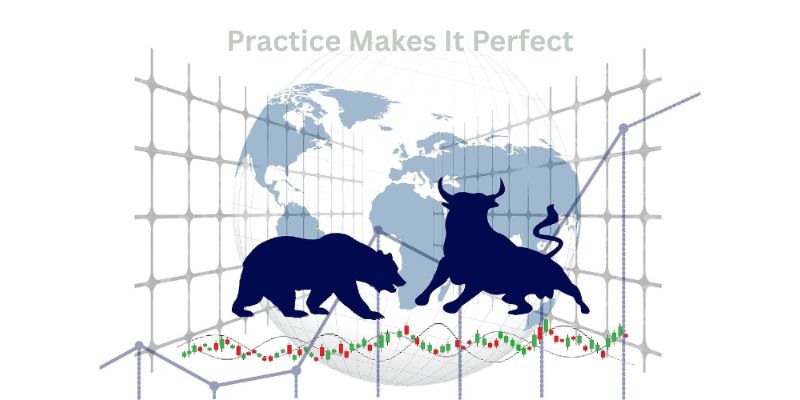Trading simulators are platforms that replicate real financial markets using virtual funds. They’re designed for anyone looking to understand how trading works—from complete beginners who want to get a feel for market movement, to seasoned traders testing new strategies without the risk of losing capital.
Simulators serve a critical role in preparing traders for the realities of live markets. They give users a way to develop timing, technique, and platform familiarity in a controlled environment. While they don’t fully capture the emotions or unpredictability of trading with real money, they come close enough to offer meaningful practice.
How Trading Simulators Work
A trading simulator works by offering a simulated trading environment that behaves like a real one, but without financial consequences. Users are given a balance of virtual currency to place trades based on either live or delayed market data.
Key features typically include:
Live or Delayed Market Data: Many simulators use real-time price feeds, allowing trades to be based on actual market conditions. Others may use delayed data, especially in free versions.
Charting Tools and Technical Indicators: Most platforms come with interactive charts and indicators—moving averages, RSI, MACD, Bollinger Bands, and more—to test strategies visually.
Virtual Balances: These give you a chance to test money management approaches and adjust position sizing without risking capital.
Multiple Asset Classes: Depending on the platform, users can trade forex, stocks, commodities, futures, or even cryptocurrencies.
Order Placement and Risk Management Tools: You can place market, limit, or stop orders, and set stop-losses or take-profits, mirroring what you’d do in a real trade.
Some simulators even offer back-testing capabilities, letting users run strategies on historical data to analyse how trades might have played out under past market conditions.
Why Use a Trading Simulator?
Trading simulators offer a range of benefits, and while they’re not a substitute for real trading experience, they provide a solid foundation. Here’s why they’re worth using:
Learn Platform Mechanics: Even experienced traders can make mistakes if they’re unfamiliar with a platform’s layout. Simulators help you get used to placing trades, managing positions, and analysing charts within a particular platform’s environment.
Test Trading Strategies: Whether you’re working on a scalping technique, swing trading method, or long-term investing plan, simulators let you test your ideas risk-free. You can tweak setups, refine entry/exit points, and compare different methods under changing market conditions.
Develop Confidence: Practice leads to confidence. Seeing a strategy work (or fail) in a simulator helps build trust in your approach, making it easier to execute trades in a real account.
Work on Discipline and Patience: Even though no real money is involved, a good simulator session still challenges your decision-making process. You learn to wait for setups, follow your rules, and avoid over-trading—skills that translate directly to live markets.
Identify Weaknesses Without Financial Loss: Mistakes in trading are inevitable. A simulator gives you the space to make them early on, without the penalty of blowing up your account.
Limitations to be aware of:
Lack of Emotional Pressure: Since you’re not risking real money, the emotional intensity is reduced. That means your behaviour in the simulator may not match how you react when real stakes are involved.
Market Conditions May Be Idealised: Some simulators don’t account for slippage, illiquidity, or fast-moving gaps. In live trading, especially in volatile markets, these factors can significantly affect trade outcomes.
Top 5 Trading Simulators to Explore
Here are five trading simulators that consistently get strong reviews from traders at various skill levels:
- Thinkorswim PaperMoney (by TD Ameritrade)
This is one of the most complete simulation environments available. It’s ideal for U.S.-based traders and those focused on equities, options, and futures. Thinkorswim’s PaperMoney mirrors the real platform, including access to all the charting tools, screeners, and risk management functions. The only catch: you need to create a TD Ameritrade account (free) to access it.
Best for: Serious strategy testing with a realistic trading interface.
- TradingView Paper Trading
TradingView is known for its intuitive layout and powerful charting tools. Its paper trading feature lets users place trades directly on charts using live market data. You can adjust your virtual account balance, simulate margin use, and test across various asset classes—from stocks and indices to crypto and forex.
Best for: Traders who rely heavily on technical analysis.
- NinjaTrader
NinjaTrader offers advanced simulation capabilities, especially for futures and forex traders. You can build and test automated strategies, run simulations on historical data, and track performance with in-depth analytics. It also allows for simulated slippage and partial fills, offering a more realistic experience.
Best for: Advanced traders and algorithm developers.
- Investopedia Stock Simulator
This browser-based simulator is simple, educational, and well-suited for beginners. Users can join contests, build portfolios, and track performance over time. It’s less about replicating real execution and more about helping users understand stock market basics.
Best for: Beginners and students interested in stock trading fundamentals.
- MetaTrader 4/5 Demo and Strategy Tester
Popular among forex traders, MetaTrader platforms offer demo accounts and a built-in strategy tester. The demo accounts use real-time pricing and allow full trade execution practice. The strategy tester, meanwhile, lets users simulate algorithmic trading using historical data.
Best for: Forex traders and those interested in automated strategies.
Are Trading Simulators Really Helpful?
Trading simulators provide a meaningful way to build experience before risking capital. They give traders space to test strategies, learn platforms, and develop a structured approach to trading—skills that are essential for success. While simulators don’t fully capture the stress and unpredictability of real trading, they serve as a valuable stepping stone.
Used properly, a simulator becomes more than just a practice tool. It becomes a way to identify what works, what doesn’t, and what still needs to be refined. For anyone serious about trading—whether just starting out or sharpening existing skills—spending time with a quality simulator is a smart investment.


